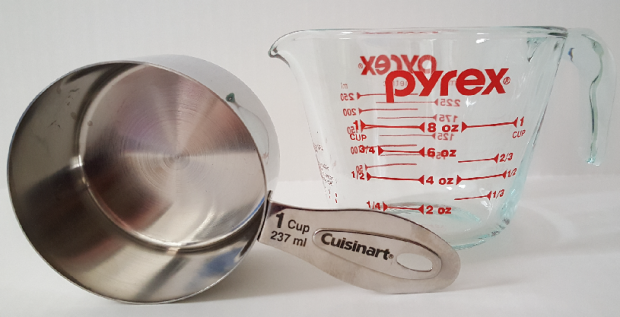
This was really difficult to photograph since the units (cups and ounces on one side and milliliters on the other) are only embossed. Most measuring cups use ink for contrast. Hopefully, the visual complexity of one side compared with the other still comes across.
Every once in a while I come across something that really lives up to the cliché of “a picture is worth a thousand words.” I thought I’d share the images above with you since it relates directly to our lack of metric system adoption.
Most glass measuring cups are fairly cleanly designed to show U.S. customary units on one side (no, we don’t use the Imperial units we originally brought over with us from the U.K) and those of the metric system on the other side.
However, the one I recently bought really puts our awkward system into full light.
Interestingly, when I pointed my find out to the person at the cash register, she indicated that she wanted one as well. Alas, as I was shopping in a discount store, I had to inform her that I was buying the only one I saw. (Frankly, I was pleased that someone else wanted something that I considered a fairly unusual item.)
Keep in mind that the whole point of having liquid measuring cups is to avoid spilling whatever one wishes to measure. In theory, the volume-based measure of, say a cup that can be leveled off at the top containing dry ingredients, should be exactly the same as for a liquid measure. The only reason for a liquid measure is to prevent spilling once the measurement is made.

Americans have both “dry” and “wet” measuring cups is so, if you need a full cup of a liquid, you don’t spill it. A liquid measuring cup provides “slosh” margin above the full-cup measure. Also, liquids tend to level themselves. “Dry” cups makes it easy to push off any excess material and make it level. That’s why you don’t normally see half and quarter cup measures listed within dry measuring cups—you couldn’t level them. [Note the ml printed on the dry measuring cup.]
There was no identifiable marker’s mark other than something that looked to me like almost a ying and yang mark. A mystery to me, but if someone else can shed light on the maker so I can get some more background—preferably in English—I’d be happy to hear it.
Thanks for reading,
Linda Anderman

” (no, we don’t use the Imperial units we originally brought over with us from the U.K)”
Imperial was brought into being by the Imperial Act, 1824. We had been separated from the UK for 48 years. We use the Queen Anne wine gallon, approved by British Parliament around 1700, for all liquids, and the Winchester bushel for grain and produce. Those are the measures “we brought over.”
I think if students knew we use the units of our former colonial masters, metric might be more popular or at least we would hear less about “Freedom units.”
Hi Linda,
An interesting posting! May I however point out one small point – you wrote “(no, we don’t use the Imperial units we originally brought over with us from the U.K)”. I assume that by the word “we”, you meant “we, the people of the United States”. The United States declared its independence in 1776 which was recognised by the British Government in 1783. The United Kingdom was only formed in 1801 when Great Britain (England, Scotland and Wales) and Ireland were united under a single government. Moreover, Imperial units date back to 1826 when the existing English system of units of measurement was overhauled. At the time the United Kingdom had three different gallons, so they invented a fourth that they called the “Imperial gallon”. In so doing, they borrowed an idea from there French – since one litre of water weighed one kilogram, they decided that one imperial gallon should weight 10 pounds (a nice decimal idea, but built on a very shaky foundation).
Meanwhile, the US had decided that they would only use the Queen Anne gallon of 1707 (which they imported from England) as their gallon. The result was a mess – the British claim that there are 20 fluid ounces in a gallon, while the Americans claim that there are 16 fluid ounces in a gallon. There US gallon is smaller than the Imperial gallon, but the US fluid ounce is larger than the imperial fluid ounce. This is of course a very good reason to adopt a common system of units of measurement, one which can be shared with the French, the Germans, the Chinese, the Japanese and everybody else in the world. It is called “the metric system”.
Hello!
I learned about your blog via the Vox podcast. I’m Turkish and I’m living in Turkey. I believe that the ying-yang-like logo you’ve mentioned could be this one: https://goo.gl/images/YL4gJ2
Pasabahce is the largest glass producer in Turkey (And as I just learned on their website, the third largest in the World). My guess is that one of their designers didn’t put too much thought into the design. “Cup” in the sense of volume measurement is virtually unheard of in Turkey.
Btw, I don’t know why but dry measure cups are also not a thing in Turkey. We have the wet measure ones though…
Thanks! That does look like the logo on the measuring cup. Mystery solved. Since it’s a glass company, that makes perfect sense. I can only image the dry measures were added for export to the U.S. Readers of this blog are just the best!